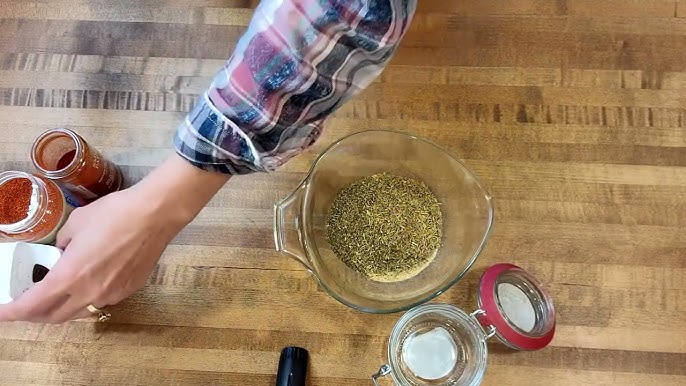Creole Seasoning Recipe: Creole seasoning is a savory, spicy, and aromatic blend of herbs and spices that originated in Louisiana. It is a staple in Creole cuisine, known for its flavorful and bold taste. This seasoning is a true representation of the melting pot of cultures that influenced Southern cooking—French, Spanish, African, and Caribbean all play a role. Think of it as the soul of Creole dishes; it transforms even the simplest meal into something unforgettable.
This mix is not just spicy; it’s nuanced. Unlike some spice blends that just burn, Creole seasoning brings a full flavor profile. The blend often includes paprika, cayenne pepper, garlic powder, onion powder, oregano, thyme, and black pepper. These components work in harmony to deliver both heat and depth.
If you’re looking for a seasoning that elevates your shrimp, chicken, rice, or vegetables, Creole seasoning is your go-to. Plus, the beauty of making it at home is you can tweak it to your taste—more heat, less salt, no problem.
History and Origin of Creole Seasoning
Creole seasoning didn’t just appear overnight; it’s rooted in the rich culinary traditions of Louisiana. The Creole people—descendants of French and Spanish settlers, along with African and Caribbean influences—developed a distinct cuisine in New Orleans. This cuisine borrowed techniques and flavors from various cultures, creating something new and delicious.
As a result, Creole seasoning became an essential building block in the kitchen. It’s used in classic dishes like jambalaya, etouffee, and red beans and rice. Unlike Cajun seasoning, which leans heavily into spiciness, Creole seasoning includes more herbs and has a more balanced flavor profile. That’s why chefs often keep both in their arsenal.
Historically, families and chefs had their own versions of Creole seasoning—some passed down through generations. Today, you can find bottled versions in stores, but nothing beats the taste of a freshly mixed batch made to your personal preferences.
How Creole Seasoning Differs from Cajun Seasoning
It’s easy to confuse Creole and Cajun seasoning because they come from the same region, but there’s a key difference: complexity vs. heat. Cajun seasoning is simpler and spicier, often just a mix of paprika, garlic powder, black pepper, and cayenne. It packs a punch but isn’t very nuanced.
Creole seasoning, on the other hand, is more herb-forward. It includes ingredients like thyme, basil, and oregano along with the classic spices. This gives it more depth and makes it suitable for a wider variety of dishes.
If Cajun is the fiery rebel of Louisiana, Creole is the sophisticated artist. It brings a refined balance to dishes, layering flavors rather than just hitting you with heat. So, when you want complexity along with spice, Creole seasoning is your best bet.
Key Ingredients in Creole Seasoning
Herbs That Make It Special
Herbs are what truly set Creole seasoning apart. Dried thyme, basil, and oregano are the holy trinity of the herb component. They add earthy, slightly sweet, and peppery notes that balance out the heat from the spices.
- Thyme gives a sharp, almost minty taste that stands up well in hearty dishes like gumbo.
- Oregano adds a hint of bitterness that enhances meat dishes.
- Basil brings a soft sweetness that rounds out the flavors.
These herbs are what give Creole seasoning its unique signature—it’s more than just spicy, it’s aromatic and flavorful.
Spices That Bring the Heat
The spice mix is where the boldness comes in. Here are the heavy hitters:
- Paprika: Adds a smoky, mild heat and a beautiful red color.
- Cayenne Pepper: The main source of heat. You can adjust the amount based on your spice tolerance.
- Black Pepper: Gives a sharp bite and enhances the other spices.
- White Pepper (optional): Adds a different layer of heat, more earthy than black pepper.
- Garlic Powder: Savory and aromatic, it builds the backbone of the flavor.
- Onion Powder: Adds sweetness and depth to the blend.
Each spice plays its role, and when combined, they deliver that unmistakable Creole kick.
Optional Add-Ins for Custom Flavor
Want to make your seasoning stand out? Add these optional ingredients:
- Celery Seed: Adds a hint of bitterness that complements meats.
- Mustard Powder: Introduces a tangy heat.
- Salt: Many prefer a salt-free blend so they can control salt separately in cooking.
- Smoked Paprika: For an extra smoky depth, especially good in grilled dishes.
This is your seasoning—experiment and find your perfect mix. Whether you prefer it fiery hot or herbaceous and mild, the choice is yours.
Step-by-Step Guide to Making Creole Seasoning
Step 1: Gather Your Ingredients
Before you start mixing, make sure you have everything you need. Here’s a basic ingredient list:
- 2 tbsp paprika
- 1 tbsp garlic powder
- 1 tbsp onion powder
- 1 tbsp dried oregano
- 1 tbsp dried basil
- 1 tbsp dried thyme
- 1 tsp cayenne pepper (adjust to taste)
- 1 tsp black pepper
- 1 tsp white pepper (optional)
- 1 tsp salt (optional)
Use high-quality dried herbs and ground spices for the best flavor. Check that nothing is expired—stale spices can ruin your blend.
Step 2: Measure the Ingredients Precisely
Accuracy matters. Use measuring spoons rather than guessing. This ensures consistency every time you make it. Feel free to scale up the recipe if you’re cooking often or want to store it in bulk.
Start by laying out small bowls and measuring each ingredient individually. This helps avoid mistakes and lets you see the balance of the mix before combining.
Step 3: Mix Everything Evenly
Once you’ve measured all the ingredients, it’s time to mix. Pour them into a medium-sized bowl and stir thoroughly with a spoon or whisk. You want to make sure each spice and herb is evenly distributed throughout the blend. No one wants a mouthful of cayenne in one bite and none in the next.
If you’re making a large batch, you can use a food processor or spice grinder, but pulse lightly. Over-mixing or grinding too fine can change the texture and even the flavor profile.
A handy trick: Once mixed, pour the blend onto a sheet of parchment paper and gently shake it back and forth. This not only ensures even mixing but also makes it easier to transfer into storage containers.
Step 4: Store It Properly for Future Use
Storage is where many people go wrong. Spices are sensitive to air, moisture, and light. To keep your Creole seasoning fresh and flavorful:
- Use an airtight container like a glass jar or spice container with a tight-fitting lid.
- Store it in a cool, dark place, such as a pantry or cabinet. Avoid keeping it near the stove or in direct sunlight.
- Label the container with the name and date so you remember when you made it.
Properly stored, your homemade Creole seasoning will stay fresh for up to 6 months. After that, it’s still usable but might lose some of its punch.
Tips for Perfecting Your Homemade Creole Seasoning
Balancing Flavors
The magic of a great spice blend is in balance. Creole seasoning should be bold but not overwhelming. Too much cayenne can drown out the herbs; too many herbs can mute the spice.
A good rule of thumb is the 3-2-1 ratio: 3 parts milder spices (like paprika), 2 parts aromatic (garlic/onion powder), and 1 part heat (cayenne/pepper). This gives you a balanced mix with flexibility to adjust according to personal taste.
If your first batch tastes off, adjust one ingredient at a time. Taste, tweak, repeat. It’s all part of the process.
Adjusting the Heat
Everyone has a different spice tolerance, so the beauty of homemade seasoning is the ability to control the heat level. Like it fiery? Add more cayenne or even crushed red pepper. Prefer it mild? Cut the cayenne in half or omit it altogether.
Another option is to include smoked hot paprika instead of regular paprika. It brings smoky heat that’s flavorful without overwhelming spice.
Always remember: you can add heat, but you can’t take it away. Start mild and build from there.
Fresh vs. Dried Herbs and Spices
While this recipe uses dried herbs and spices for convenience and shelf-life, fresh versions offer a totally different flavor experience. However, fresh herbs aren’t suited for a dry blend, unless you’re using them right away.
If you’re cooking a dish immediately, you can substitute fresh for dried, but use three times the amount (e.g., 1 tsp dried = 1 tbsp fresh). But for spice blends intended for storage, stick with dried.
And remember, fresher is always better. Check your spice rack regularly and replace anything that smells musty or has lost its vibrant color.
Best Ways to Use Creole Seasoning
In Meats and Grilled Dishes
Creole seasoning shines on proteins. Rub it generously onto chicken, shrimp, or pork before grilling, roasting, or pan-frying. For a deeper flavor, combine it with olive oil or lemon juice to create a marinade.
Try it on:
- Grilled chicken breasts
- Blackened fish fillets
- Creole-spiced pork chops
- Seasoned shrimp skewers
It forms a delicious crust when seared and locks in moisture and flavor. Don’t be shy—let it really coat the meat. You’ll thank yourself after the first bite.
In Soups, Stews, and Gumbos
There’s no better place for Creole seasoning than in hearty, soulful dishes like gumbo, jambalaya, and stews. It’s the backbone of flavor that ties the ingredients together.
Add 1-2 tablespoons while sautéing onions, celery, and bell peppers (the “Holy Trinity” of Creole cuisine). This helps release the flavors early, so they infuse into the entire dish.
You can also stir it in toward the end of cooking for a stronger kick. It’s perfect for:
- Seafood gumbo
- Chicken and sausage jambalaya
- Red beans and rice
You’ll instantly notice how it deepens the flavor, giving your dish that authentic Louisiana flair.
Creative Uses Beyond Traditional Dishes
Think beyond gumbo! Creole seasoning is incredibly versatile and can spice up all sorts of everyday meals.
- Roasted vegetables: Toss carrots, potatoes, or cauliflower with olive oil and Creole seasoning before roasting.
- Popcorn: Sprinkle a pinch over buttered popcorn for a spicy movie-night treat.
- Eggs: Add to scrambled eggs, omelets, or deviled eggs for a flavorful twist.
- Fries or chips: Use it as a dry rub for homemade fries or even on tortilla chips.
- Salad dressing: Mix with olive oil and vinegar for a Creole vinaigrette.
Your pantry staple just became your kitchen’s MVP.
FAQs about Creole Seasoning Recipe
What is Creole seasoning made of?
Creole seasoning typically includes a blend of paprika, garlic powder, onion powder, thyme, oregano, cayenne pepper, black pepper, and salt. Some variations may also include basil, white pepper, and celery seed for added depth.
Is Creole seasoning the same as Cajun seasoning?
No, Creole and Cajun seasonings are similar but not identical. Creole seasoning tends to be more herb-forward, while Cajun seasoning is spicier and has a simpler spice blend. Both originate from Louisiana cuisine.
Can I use Creole seasoning for seafood?
Absolutely! Creole seasoning works beautifully on shrimp, crab, crawfish, and fish. It adds a bold, savory flavor that enhances most seafood dishes.
How spicy is Creole seasoning?
Creole seasoning has a mild to moderate heat level. You can adjust the spiciness by increasing or decreasing the amount of cayenne pepper in your homemade blend.
How long does homemade Creole seasoning last?
When stored in an airtight container in a cool, dry place, homemade Creole seasoning can last up to 6 months while maintaining its flavor and aroma.
Can I use Creole seasoning as a substitute for other spice blends?
Yes, it can substitute for Cajun seasoning, Old Bay, or even taco seasoning in a pinch. However, it will slightly alter the taste due to its unique herb and spice profile.
Can I use Creole seasoning as a substitute for other spice blends?
Most homemade Creole seasoning recipes are naturally gluten-free. However, always check labels on store-bought versions for additives or fillers that may contain gluten.
Can I reduce the salt in Creole seasoning?
Yes, feel free to reduce or omit the salt entirely if you’re watching your sodium intake. You can add salt separately to your dish to control the level more precisely.
Conclusion
By making your own Creole seasoning at home, you’re not just adding flavor to your meals—you’re adding your personal touch. You control the heat, the herbiness, the salt, and the spice. It’s about finding that sweet spot where every bite sings.
Don’t just save this blend for gumbo or jambalaya. Use it to bring excitement to your everyday cooking. From meats and vegetables to popcorn and eggs, this versatile mix has endless potential.
So go ahead—make a big batch, store it right, and start experimenting. Your kitchen will smell amazing, your taste buds will thank you, and your friends will probably start asking for your “secret” recipe.



